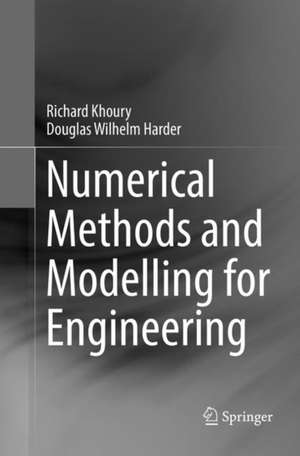Numerical Methods and Modelling for Engineering
Autor Richard Khoury, Douglas Wilhelm Harderen Limba Engleză Paperback – 26 mai 2018
This textbook provides a step-by-step approach to numerical methods in engineering modelling. The authors provide a consistent treatment of the topic, from the ground up, to reinforce for students that numerical methods are a set of mathematical modelling tools which allow engineers to represent real-world systems and compute features of these systems with a predictable error rate. Each method presented addresses a specific type of problem, namely root-finding, optimization, integral, derivative, initial value problem, or boundary value problem, and each one encompasses a set of algorithms to solve the problem given some information and to a known error bound. The authors demonstrate that after developing a proper model and understanding of the engineering situation they are working on, engineers can break down a model into a set of specific mathematical problems, and then implement the appropriate numerical methods to solve these problems.
| Toate formatele și edițiile | Preț | Express |
|---|---|---|
| Paperback (1) | 457.80 lei 6-8 săpt. | |
| Springer International Publishing – 26 mai 2018 | 457.80 lei 6-8 săpt. | |
| Hardback (1) | 536.49 lei 6-8 săpt. | |
| Springer International Publishing – 23 mai 2016 | 536.49 lei 6-8 săpt. |
Preț: 457.80 lei
Nou
Puncte Express: 687
Preț estimativ în valută:
87.60€ • 91.47$ • 72.34£
87.60€ • 91.47$ • 72.34£
Carte tipărită la comandă
Livrare economică 15-29 aprilie
Preluare comenzi: 021 569.72.76
Specificații
ISBN-13: 9783319793313
ISBN-10: 3319793314
Ilustrații: XVII, 332 p. 131 illus., 77 illus. in color.
Dimensiuni: 155 x 235 mm
Greutate: 0.49 kg
Ediția:Softcover reprint of the original 1st ed. 2016
Editura: Springer International Publishing
Colecția Springer
Locul publicării:Cham, Switzerland
ISBN-10: 3319793314
Ilustrații: XVII, 332 p. 131 illus., 77 illus. in color.
Dimensiuni: 155 x 235 mm
Greutate: 0.49 kg
Ediția:Softcover reprint of the original 1st ed. 2016
Editura: Springer International Publishing
Colecția Springer
Locul publicării:Cham, Switzerland
Cuprins
Modelling and Errors.- Numerical Representation.- Iteration.- Linear Algebra.- Taylor Series.- Interpolation, Regression, and Extrapolation.- Bracketing.- Root Finding.- Optimization.- Differentiation.- Integration.- Initial Value Problems.- Boundary Value Problems.
Recenzii
“This book is intended as a textbook for students, with exercises and questions at the end of each chapter, it is equally suitable for practicing engineers or computer scientists who find themselves using computers to solve numerical problems. … Overall, I found this book very easy to read and follow, with chapters flowing naturally on from each other. … this introductory text on numeric methods does provide just the right level of coverage required of a generalist.” (Bernard Kuc, Computing Reviews, February, 2017)
“The work is written clearly … and generously illustrated with frequent figures and examples. The provided ‘engineering examples’ mostly involve application of numerical techniques to simple physical situations. Each chapter includes a summary and multiple exercises for students; answers are presented inthe appendix. In short, this is an excellent text for a first course in numerical analysis. Summing Up: Recommended. Lower- and upper-division undergraduates.” (R. Darby, Choice, Vol. 54 (4), December, 2016)Notă biografică
Richard Khoury received his Bachelor’s Degree and his Master’s Degree in Electrical and Computer Engineering from Laval University (Québec City, QC) in 2002 and 2004 respectively, and his Doctorate in Electrical and Computer Engineering from the University of Waterloo (Waterloo, ON) in 2007. Since August 2008, he is a faculty member in the Department of Software Engineering at Lakehead University. Dr. Khoury’s primary area of research is natural language processing, but his research interests also include data mining, knowledge management, machine learning, and artificial intelligence.
Textul de pe ultima copertă
This textbook provides a step-by-step approach to numerical methods in engineering modelling. The authors provide a consistent treatment of the topic, from the ground up, to reinforce for students that numerical methods are a set of mathematical modelling tools which allow engineers to represent real-world systems and compute features of these systems with a predictable error rate. Each method presented addresses a specific type of problem, namely root-finding, optimization, integral, derivative, initial value problem, or boundary value problem, and each one encompasses a set of algorithms to solve the problem given some information and to a known error bound. The authors demonstrate that after developing a proper model and understanding of the engineering situation they are working on, engineers can break down a model into a set of specific mathematical problems, and then implement the appropriate numerical methods to solve these problems.
- Uses a “building-block” approach, starting with simpler mathematical tools and using them to develop more and more complex models and methods;
- Integrates modelling, error measuring, and programming, with numerical methods, in order to give an engineering emphasis to an otherwise mathematical topic;
- Demonstrates not only how the math and algorithms work but also how they can be used in engineering practice.
Caracteristici
Uses a “building-block” approach, starting with simpler mathematical tools and using them to develop more and more complex models and methods; Integrates modelling, error measuring, and programming, with numerical methods, in order to give an engineering emphasis to an otherwise mathematical topic; Demonstrates not only how the math and algorithms work but also how they can be used in engineering practice. Includes supplementary material: sn.pub/extras





















